The past week has definitely seen a nearly-geometric increase in my average annual intake of Faroese literature. I started and finished Barbara, perhaps the most famous book to emerge from the Faroes, despite being written in Danish. The author, Jørgen-Frantz Jacobsen, died in 1938 before he could finish his novel of a headstrong Faroese women and her relationship with a Danish pastor. Thus the book ends abruptly, which many readers (including myself) find just as well -- the 1997 film version attempted to tack on the best guess as to what Jacobsen would have written had he survived tuberculosis, with decidedly mixed results.

The story's incompleteness only adds to the book's sense of drama -- in the middle of the North Atlantic, hundreds of miles away from anywhere, and amidst a constant drizzle, Jacobsen manages to portray 18th-century Faro as a crucible of temptation and sensuality for Poul Aggersøe, a Danish pastor sent from Copenhagen to take over the parish of Vågøy (Faroese Vágar). Aggersøe's predecessor left behind a widow when he died. Barbara is a 29-year-old free spirit who has been engaged three times, married twice, and survived two husbands whose lifetimes -- according to some in the islands -- were not extended by their marriages to her.
What could a up-and-coming Dane possibly want with a provincial woman with this kind of past? For Aggersøe, Barbara is the only spark of life on the dull, damp Faroes. He accepted his post here with an eye towards both completing his own spiritual journey as well as advancing his career in the church but he finds a place whose starkness and isolation confound his cosmopolitan soul. With her fondness for fine silks and dresses (smuggled through the Royal Trade Monopoly's guard), her physical beauty, and her direct and mischievous personality, Barbara confronts Aggersøe with a bewitching temptation, one at odds with both what he thought he wanted from life as well as what the other Faroese and Danes expect of him. Likewise, to the reader, Jacobsen presents perhaps one of the most distinctive and memorable female characters in Scandinavian fiction of the 20th century, a figure on the periphery of Europe whose life nevertheless touches the transition from Mercantilism to Capitalism, Linnéan botany, the Napoleonic Wars, and the relationship between colonized and colonizer.